Salty plums have been beloved for centuries across East Asia, not only as flavorful snacks but also as traditional remedies. But did you know that the salty plum in Japan is quite different from the salty plum in China? These two iconic versions may look similar at first glance, but they vary in taste, texture, production methods, and cultural significance.
So, what exactly makes Japanese salty plums different from their Chinese salty plum counterparts? From preparation methods to health benefits, this article will help you understand the key distinctions between salty plum Japan and salty plum China and why each holds a unique place in culinary and wellness traditions.
I. What Is a Japanese Plum (Umeboshi)?
Salty plum Japan, also known as ‘Umeboshi’, is one of the traditional dishes of Japan, famous for its extremely characteristic salty-sour taste. Not only popular in cuisine, umeboshi is also considered a functional food that is beneficial for health, appearing from family meals to student bento lunch boxes. Want to try making your own at home? Here’s our Homemade Sour Salted Plums: Easy Traditional Recipe.
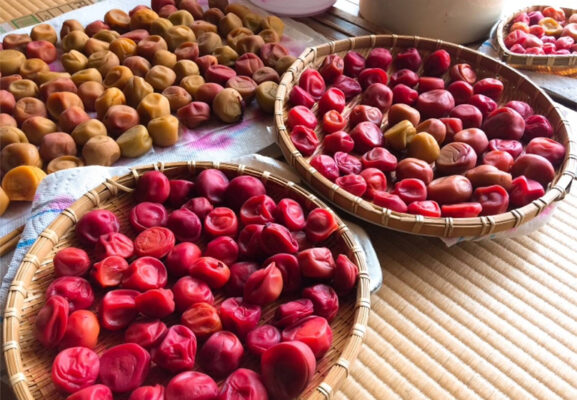
1. What Fruit Is Used?
Although often called a “Japan salty plum,” umeboshi is not technically a true plum. It is made from the Ume fruit, a unique fruit that falls between a plum and an apricot in terms of species. Ume originally came from China but was introduced to Japan over a thousand years ago. Since then, it has been cultivated and crossbred extensively, becoming a distinct part of Japanese agriculture and cuisine.
When raw, Ume fruit is small, green, very firm, and extremely sour. Due to its high acidity, it is not eaten raw and must be processed to become palatable and safe. The traditional method involves salting and drying the fruit, often with the addition of shiso leaves, which give umeboshi its deep red color and extra flavor complexity. Once processed, it becomes umeboshi—a highly distinctive, salty-sour preserved fruit.
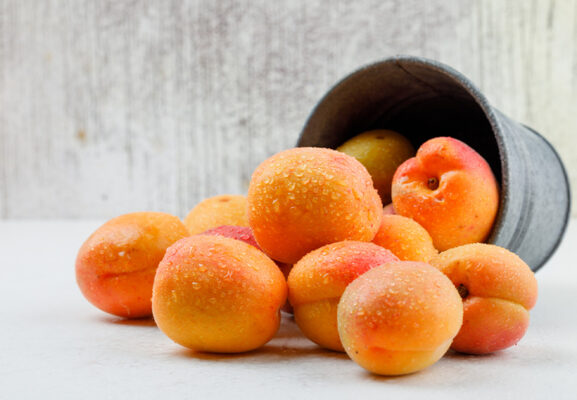
2. Taste and Appearance
In terms of appearance, salty plum Japan are usually small in size, wrinkled on the surface, red in color thanks to perilla leaves, sometimes slightly sweet if combined with honey.
The most outstanding flavor of umeboshi is:
- Extremely salty and sour, enough to make you grimace at first taste.
- The sour taste combined with the strong saltiness creates a “living spice” that is very popularly used in rice balls (onigiri) or eaten with white rice.
This is one of the typical dishes that can implement Japanese food nutrition: simple but sophisticated and always aiming for health benefits.
II. What Is a Chinese Salty Plum?
The salty plum China comes in many forms and regional variations but generally refers to preserved plums that are salted, dried, and sometimes flavored with licorice, sugar, chili, or herbs. In Chinese, these are known as 话梅 (huà méi) or 乌梅 (wū méi), depending on the preparation.
Unlike the Japanese version, Chinese salty plums come in a wider range of flavors. They can be sweet and salty, or sour and spicy. These plums are often eaten as snacks, shared during festivals, or used in traditional medicine. Common health uses include aiding digestion and soothing sore throats. Some versions are soft and chewy, while others are hard and crystallized.
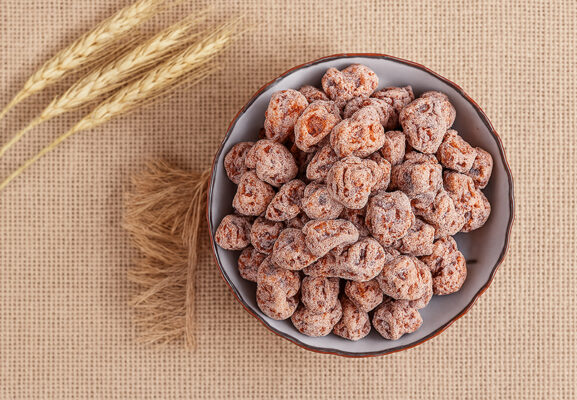
III. Key Differences Between Japanese and Chinese Salty Plums
| Aspect | Salty Plum Japan (Umeboshi) | Salty Plum China (Huamei/Wumei) |
| Origin | Japan | China |
| Fruit Base | Pickled apricot (ume) | Actual plums (huamei or wumei) |
| Flavor Profile | Very salty and sour; sharp and tangy | Varies: sweet-salty, sour, spicy, or herbal |
| Processing Method | Salted, sun-dried, and fermented with red shiso leaves | Salted, sometimes sugared or flavored with licorice, herbs, or chili |
| Color and Texture | Reddish, soft, moist | Brown to dark black; chewy, hard, or crystallized |
| Culinary Use | Eaten with rice, used in onigiri, or as a condiment | Consumed as a snack or used in herbal remedies |
| Cultural Significance | Iconic in Japanese cuisine and traditional health practices | Common in Chinese medicine and festive traditions |
| Health Perception | Alkalizing, supports digestion, boosts energy | Soothes throat, aids digestion, used for detoxification |
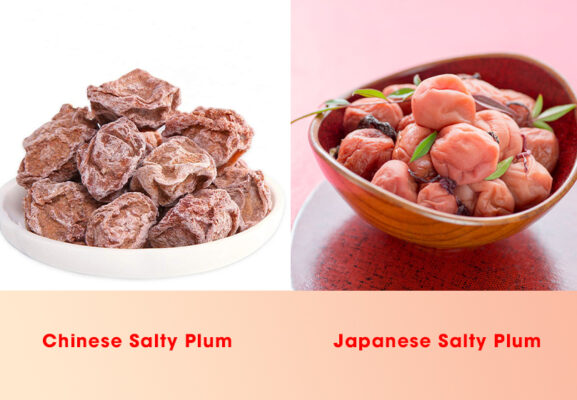
IV. Health Benefits of Japanese Plums
The salty plum Japan—commonly known as umeboshi—is more than just a traditional food. In Japanese culture, it’s long been appreciated as a natural remedy and functional food with a wide range of wellness benefits.
- Digestive Aid: Umeboshi is traditionally believed to stimulate digestion, improve gut balance, and relieve bloating, especially when consumed with plain rice.
- Alkalizing Effect: Though incredibly sour, umeboshi is said to have an alkalizing effect on the body, helping to balance internal pH.
- Anti-fatigue Remedy: In Japanese folk medicine, the salty plum Japan is often used to reduce fatigue, especially during hot summers or periods of physical exhaustion.
- Natural Preservative: Thanks to its high salt content and organic acids, umeboshi can prevent bacterial growth, which is why it’s traditionally placed in rice (as seen in Hinomaru Bento) to keep meals fresh longer.
Overall, Japanese salty plums are seen as both a culinary accent and a symbol of natural health preservation in Japanese households.
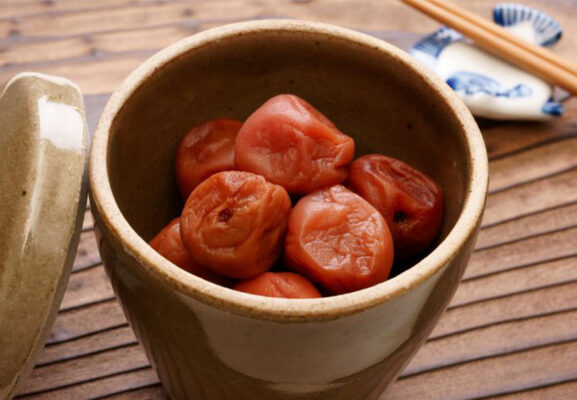
V. Health Benefits of Chinese Salty Plums
Like their Japanese salty plum, the Chinese salty plum also plays a role beyond flavor—serving as a traditional remedy across many regions in Chinese culture.
- Soothe Sore Throats: Chinese salty plums are often enjoyed as lozenges or snacks to relieve throat irritation, coughing, and dryness.
- Digestive Support: In Traditional Chinese Medicine (TCM), they are used to aid digestion, support liver function, and reduce symptoms like nausea or bloating.
- Detoxification: Certain types of salty plum from China, especially smoked plums (wumei), are believed to detoxify the body and support intestinal health.
- Appetite Booster: The tangy, salty-sweet flavor stimulates salivation and can naturally increase appetite—often eaten before meals as a palate starter.
Thanks to their unique flavor and perceived healing properties, Chinese salty plums remain a trusted home remedy and nostalgic treat across generations.
VI. Conclusion
While they share the name “salty plum,” the salty plum Japan and salty plum China are quite different in taste, tradition, and purpose. Umeboshi are central to Japanese cuisine and holistic health, while Chinese salty plums serve as versatile snacks and medicinal treats.
If you’re drawn to intense, mouth-puckering sourness with a long history of health benefits, Japanese umeboshi might be your choice. But if you prefer variety and complexity—ranging from sweet to spicy—the Chinese version offers a flavorful journey.
No matter which one you choose, both types of salty plums offer a delicious taste of tradition, wrapped in centuries-old wisdom and care.
👉 Learn more about the history of salty plums here: What Are Salty Plums and Why Do People Love Them?
